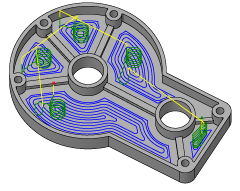2D Pocket milling strategy
The 2D Pocket toolpath is a roughing operation with options for creating a finishing pass. You can clear a cavity, open pocket, or the area around a boss. The toolpath resembles the shape of the boundary being machined. The machining area can be selected from edges, sketches, or a solid face. The toolpath also includes options for tapered walls and pre-drilling entry positions.

2D Pocket toolpath machining internal pockets.
Machining multiple pockets
You can select multiple pockets, also at different heights, to machine during an operation. The strategy aims to optimize the toolpath for machining efficiency. To machine pockets in the order that you selected them, on the Passes tab, select the Preserve Order checkbox.
Comparing 2D Pocket and 2D Adaptive
2D Pocket generates a smaller program file size when compared with 2D Adaptive, which makes it more suitable for older machine tools that have a low memory capacity.
Another difference between 2D Adaptive and 2D Pocket is that 2D Pocket assumes a boundary that it must stay within. 2D Adaptive has the ability to approach from the outside and move in to cut the stock.